BACK
TO WEATHER-BLOG MENU
New!
Fine Art Prints & digital images for sale-
Welsh Weather
& Dyfi Valley landscapes Slide-Library - Click HERE
With
a lack of interesting weather of late, I thought I might head up into
the hills on a sunny August afternoon, into the heart of the Plynlimon
range, pictured below on a thundery day in late June. The obvious track
winding its way over the hills is manageable with a 4x4 but is getting
very rutted in places - car drivers are better-off avoiding it and
walking. It passes Foel Fadian and the incredible ravine of
Esgairfochnant, runs above the Montgomeryshire Wildlife Trust Reserve
at Llyn Glaslyn and up over a shallow ridge, before moving on to one of
my favourite areas, the country around Bugeilyn. Here is a wilderness
to walk in dreams...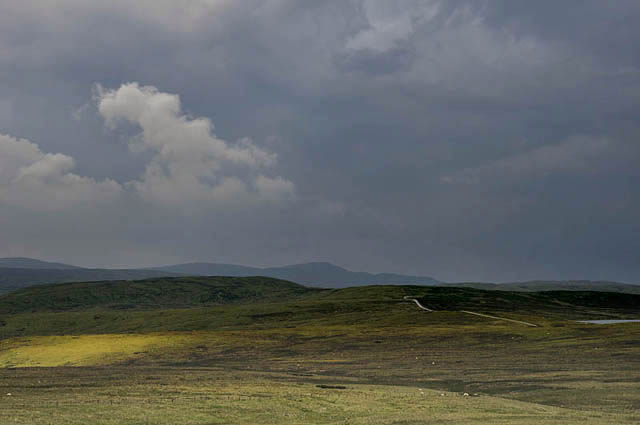 Many times I have been up here, sitting in quiet contemplation or looking for flint arrowheads (with a complete lack of success!), amid the peat-hags and their blazing fringes of heather. The first thing you come to along the track is the ruined farmstead of Bugeilyn with its stand of ash trees. I remember this place when it was in a better state, but that was many years ago.... 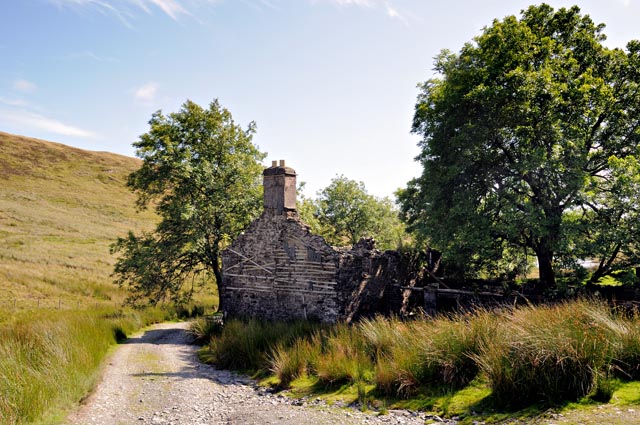 A right turn here takes you out across the moor to the dam of Llyn Cwm-Byr, the smaller of the two lakes and connected to Bugeilyn by a short sluggish channel.... 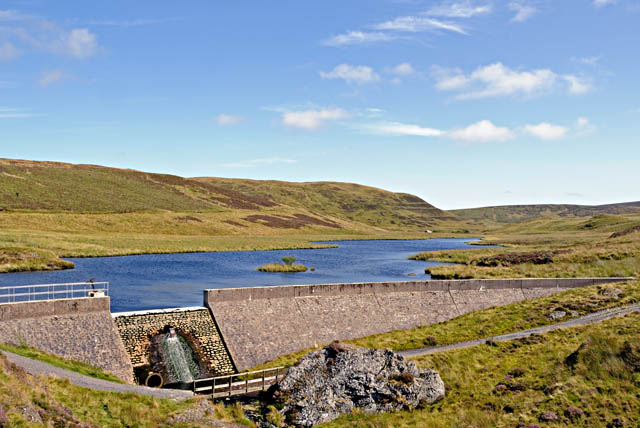 Beyond, the ground plunges away steeply down to the rolling hill-pastures that form the immediate flanks of the Dyfi Valley... 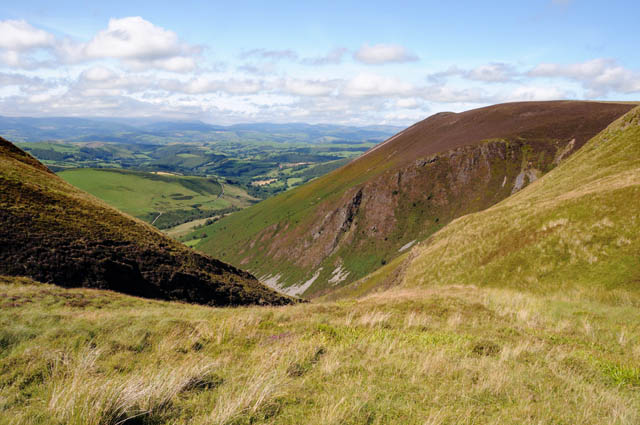 Heading back to the track, stopping to pop a ripe bilberry into my mouth here and there, I came across this unusual sight, literally in the middle of nowhere (my walking staff - a standard broomhandle - for scale): 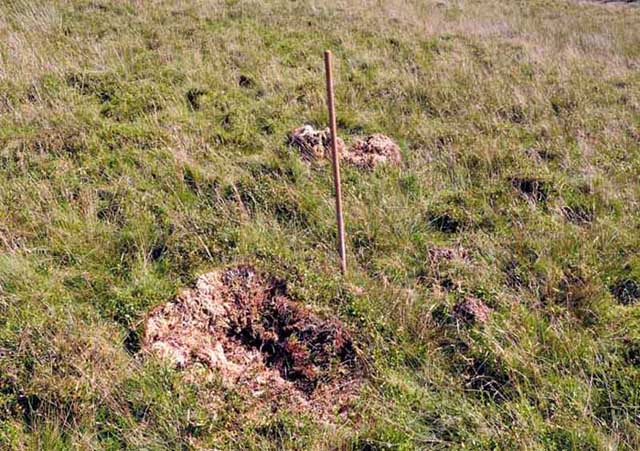 A large (and tough) tussock of bilberry, heather and moss with a chunk blown clean out of it! 2 litre water-bottle for scale... 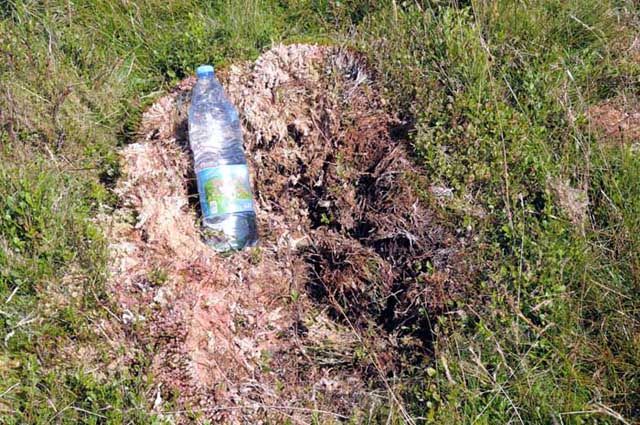 And, a few metres away, the resting-place of the ejected mass! It would have weighed few tens of kilos.... 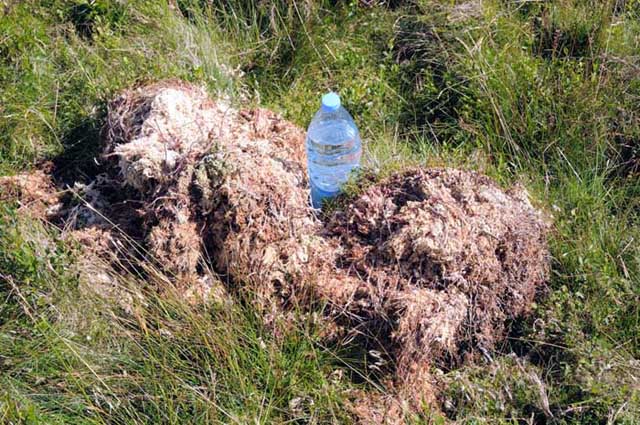 What had happened? Well, a lot of thunderstorms affected this area about 6 weeks ago (see the last but one diary-entry), and in the absence of a better explanation (yes, you bet I searched for the meteorite!), I decided to attribute this damage to a powerful bolt of lightning, vapourising the water content of a wet tussock and blowing it apart by explosive steam expansion. If anyone has a better idea let me know! I have seen similar (but more dramatic) features in rocky soil up on the Arans and the National Park warden for Cadair Idris contacted me some time ago to report one found high on that mountain too. I retraced my steps to the ruined farm and turned along the track that runs down to and then alongside Bugeilyn, with its yellow water-lilies and reedy margins. The boathouse pictured below caters for anglers, seeking the quiet solitude of this place and the brown trout that can sometimes go into feeding-frenzy mode when there is a major hatch of flies or beetles.... 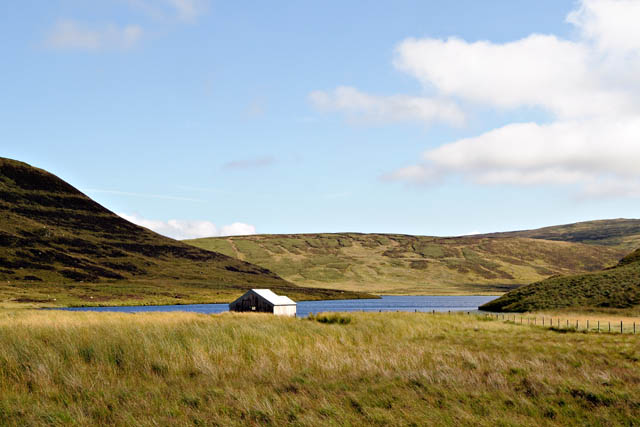 Beyond Bugeilyn lies the valley of the Hengwm that runs down to Nant-y-moch reservoir. The water from Bugeilyn does the trip more quickly via a tunnel - these lakes are all parts of a hydro-electric system. Climbing down to the valley-floor, I walked amongst tussocks of heather and out across flat eroded peat - old turf-diggings over a century old. This is the view west towards Bryn Cras, with Plynlimon hidden beyond.... 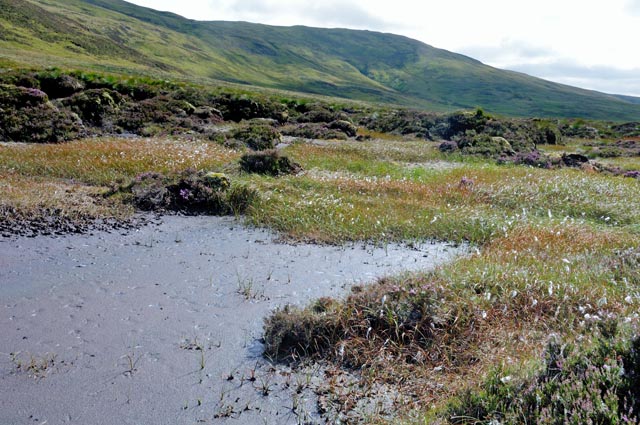 Ancient bogwood protruded from the ground in places - birch, hazel and other woods that once flourished here at 450m above sea-level. I continued past drifts of waving cotton-grass, keeping to the near-black peat, scanning its surface as I had done on other occasions over the last 20 years... 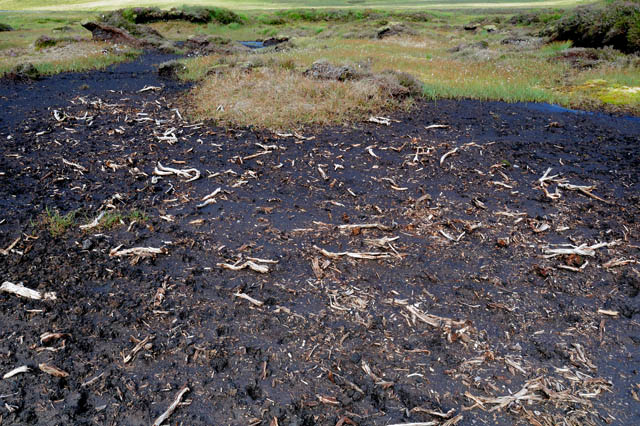 Rounding a corner, I at last espied a familiar sight - well, familiar in that it was something I had seen before: if only illustrated in an archaeological journal published in the 1920s..... 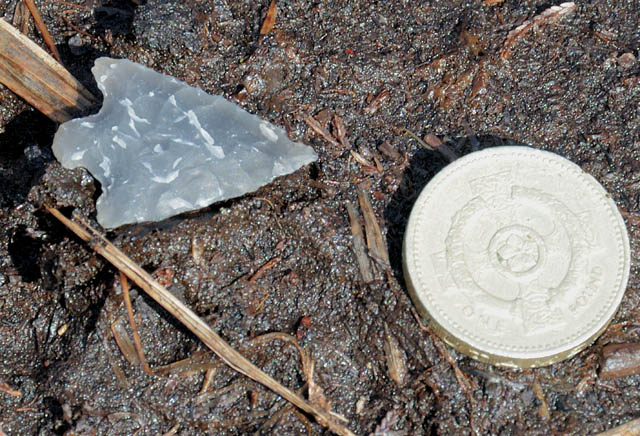 A perfect Beaker-period chalcedony arrowhead, lying flat on the peat where some eroding current of floodwater had left it. Whoever made it did so between 4500 and 3800 years ago. Let's go for the vaguely middle ground and give it 4150 years old. I stopped and for a time contemplated the changes, the transitions that had taken place between its manufacture and my finding it. It seemed appropriate to photograph it where it lay, next to a modern pound coin. 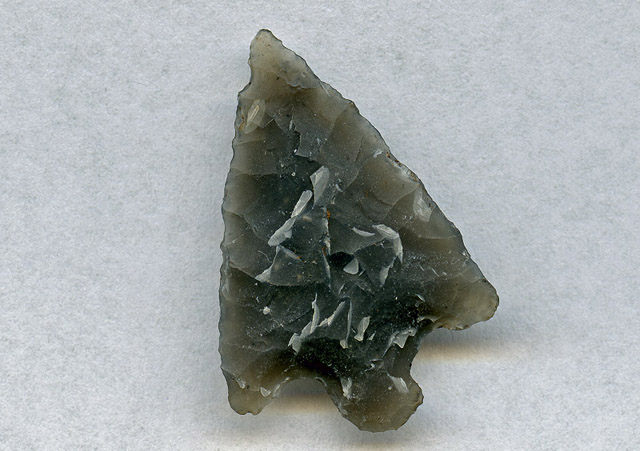 To whoever had so painstakingly made it (detail in image above brought out with my scanner), the notion that in two millennia the land would be part of the Roman Empire would have seemed pure fantasy: likewise that the trees amongst which they hunted would in four millennia simply be crumbling fragments in the peat on a windswept moor. And how about the notion that during that fifth millennium that followed, I would obtain the first ever digital image of it, using a camera with more computing power than was available to the system that succeeded in putting men on the moon 40 years previously. How would they have got their heads around that one? Such things are vast, impenetrably to outrageously vast concepts, as incomprehensible as our imagining the year 6000 AD. The future can seem so big and terrifying sometimes, especially with the looming spectres of climate change and oil depletion, but in reality we know even less about it than we do about the lives of the people who hunted here along Afon Hengwm in late Neolithic times. Perspective got the better of me. I carefully wrapped the find, put it in my shirt pocket and went on my way.  So, what can we tell about the culture and the climate back then, when our arrowhead-maker lived up here? Let's look at this in the context of the known history of Man in Britain. This goes way back! Palaeolithic (Old Stone Age) - 2,500,000-10,000 years ago  This vast timespan represents the earliest known period of human occupation of what is now the UK. It's amazing to think that on the timescale above, the Palaeolithic (in red) occupies virtually all of the black time-bar! It encompasses several glaciations and interglacial periods, both of which would have radically affected the viability of human settlement. The inhabitants of the UK at this time would have been bands of hunter-gatherers who roamed throughout northern Europe following herds of food animals or catching fish. Who were the earliest UK inhabitants? There is evidence from bones and flints found in coastal deposits in East Anglia that a species of Homo was at large around 700,000 years ago, while other sites in the southern UK indicate the later arrival of another species approximately 500,000 years ago. These early peoples made primitive flint hand-axes and hunted the large native mammals of the period, such as elephant, rhino and deer. We are permitted to live in the UK by its benevolent climate and the past was no exception to this rule. The extreme cold of the following Anglian glaciation almost certainly drove humans out of the UK altogether and the region does not appear to have been occupied again until the ice receded during the following Hoxnian Interglacial. More advanced flint technology was introduced during this warmer stage, permitting more efficient hunting right through to the next glaciation, the first of three during the Wolstonian, which began about 352,000 years ago. There were two less cold interglacials during this long period, but they were cooler than the Hoxnian and the next major warm spell, the Eemian, beginning about 130,000 years ago. There is little evidence of human occupation during the Eemian. Meltwaters from the last Wolstonian glaciation had cut the UK off from continental Europe - which may explain the apparent lack of activity. Overall, there seems to have been a gradual decline in the human population between the Hoxnian and Eemian. With a massive ice-cap covering much of the country during the Wolstonian, perhaps this is unsurprising! Neanderthal man had arrived in Britain by around 40,000 years ago, during the cold conditions that typified the Weischelian, the last of the great ice-ages. Homo Sapiens seems to have followed along about 10,000 years later, but the last glacial maximum, about 18,000 years ago, may well have pushed him back out again! By the end of the Weischelian glaciation, Man was moving more widely and creating a diverse range of tools, including leaf-shaped arrowheads, tabular scrapers, spears and knives. Mesolithic (Middle Stone Age) - 10,000-6000 years ago  The Holocene era, the era we still live in, began 10,0000 years ago. The cold of the glaciation was replaced by interglacial conditions with temperatures rising towards levels similar to those of today. Forests expanded as the warmer conditions set in, and sea-levels rose, cutting Britain off from Ireland and continental Europe. The environment was populated by pine, birch and alder woodland inhabited by wild boar, wild cattle (aurochs), red and roe deer. The life of Mesolithic Britons seems to have been a complex picture of part-nomad, part-seasonal occupier and possibly in some areas in some cases, permanent occupier, with attendant land and food source management under favourable environmental conditions. Increasing population and the need for reliable sources of food led to a transition to agriculture, ushering in the Neolithic age. Neolithic (New Stone Age) - 4000-2200 BC or 6000-4150 years ago  The Neolithic was the period when domestication of plants and animals took off in the UK. Whether this was by the invention of new practices by residents or brought in by incomers is a topic of debate within the archaeological community and there is much current work involving DNA mapping of human migrations which tends to suggest the incomers were responsible, but the matter is not totally concluded. Forests were decreasing and grassland increasing and although winters were typically colder than today's, the summers were a fair bit warmer - by as much as 2-3C. The Neolithic embraces much of a time known widely as the Mid-Holocene Climate Optimum. According to Realclimate: "This is a somewhat outdated term used to refer to a sub-interval of the Holocene period from 5000-7000 years ago during which it was once thought that the earth was warmer than today. We now know that conditions at this time were probably warmer than today, but only in summer and only in the extratropics of the Northern Hemisphere. This summer warming appears to have been due to astronomical factors that favoured warmer Northern summers, but colder Northern winters and colder tropics, than today." The Neolithic saw the development of societies becoming divided into differing specialist groups of farmers, artisans and leaders. Forests were deliberately cleared to provide space for cereal cultivation and grazing. Domesticated native cattle and pigs were reared whilst sheep and goats were later introduced from the continent as were wheat and barley. These people made trackways, stone-built houses, barrows and chambered tombs and used potteryware and much more ornate flint tools. Towards the middle of the Neolithic, the first stone circles appeared, whilst the later part of the period saw the erection of great monuments such as Stonehenge. This was the time of the next transition, into the Bronze Age, marked by the coming, during late Neolithic times, of the Beaker People, known for their distinctive pottery, skills with gold and exquisite flintwork, such as the arrowhead illustrated on this page. Bronze Age - 2200-750 BC or 4150-2750 years ago  The Beaker People brought with them, probably from the Iberian Peninsula, the vital techniques of refining metals from their ores. They must have been seen as mighty wizards! At first, copper dominated, but from around 2,150 BC at the latest, they had worked out how to make bronze by alloying copper with tin to make a much harder metal, from which very effective weaponry could be made. The transition away from flint had begun. In Mid-Wales, there are several sites where these people mined copper, including one only 10 minutes' walk from Machynlleth that I helped excavate in 1997. During the Bronze Age, the climate deteriorated so that warm and dry conditions gave way to a cooler and particularly wetter regime. This in turn forced populations away from easily-defended sites in the hills down into the fertile valleys. Large livestock farms developed in the lowlands that appear to have contributed to economic growth and inspired increasing forest clearances. Social groups appear to have been tribal but with growing complexity and hierarchies becoming apparent. The Iron Age - 750 BC - 43 AD or 2750-1967 years ago  In around 750 BC iron smelting and working techniques reached Britain from southern Europe. Stronger and more abundant than bronze, its introduction revolutionised many aspects of life, most importantly agriculture. Iron tipped ploughs could work far more quickly and deeply than older wooden or bronze ones, and iron axes could clear forest much more efficiently for agriculture. There was a landscape featuring arable culture, pasture and managed woodland. Iron Age Britons lived in organised tribal groups, ruled by chieftains, and as the population grew, war between opposing tribes became an increasing feature of life. This is probably a key reason for the building of the hill-forts which started to appear around 1500BC and became common thereafter, only starting to fall out of use a few hundred years before the Roman Occupation. There are a good number of these forts in Mid-Wales. A cool wet climate persisted through much of this time, only easing up significantly around 300BC - this marking the transition to the warmer conditions of Roman times. It just amazes me to think of what has happened in the time between now and when that arrowhead was made. The changes, both in the evolution of human culture and ingenuity and in how the environment permitted various activities, have been profound. Ancient sites are good places to sit on a still evening and contemplate such things...... |
|
BACK TO WEATHER-BLOG MENU New! Fine Art Prints & digital images for sale- Welsh Weather & Dyfi Valley landscapes Slide-Library - Click HERE |